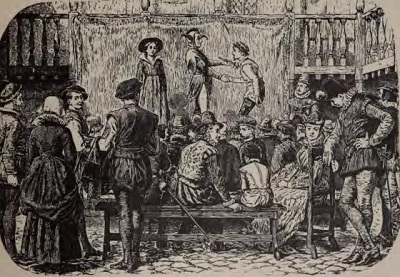|
|
Chronological List of Elizabethan, and Quasi-Elizabethan, Playhouses (1576 - 1663)
The Theater.
Unroofed theatre; situated in Moore-fields, Shoreditch; built by James Burbage, 1576; pulled down, 1598; authentic views, none. 1
The Curtain.
Unroofed theatre; situated in Moore-fields, Shoreditch; built in 1576; pulled down c. 1630; last referred to in 1627; authentic
views, none.
Paul's.
First roofed theatre; situated in the Choir Singing School, near the Convocation House (St. Paul's); built c. 1581; suppressed,
1590-6; last trace of, c. 1608; burnt down in Great Fire, 1666; authentic views, none.
Newington Butts.
Unroofed theatre; situated in Lambeth; built c. 1586; pulled down c. 1603; authentic views, none.
The Rose.
Small, unroofed theatre; situated on the Bankside in Southwark; built between 1587 and 1592; first referred to in 1592, last in
1603; authentic views: (Exterior) Norden's Map, 1593; Ryther's Map, 1604.
The Swan.
Unroofed theatre; situated in Paris Garden, Southwark; built 1595 by Francis Langley; pulled down c. 1635; authentic views:
(Interior) Van Buchell's sketch, after de Witt, 1596; (Exterior) Visscher's Map, 1616; Manor Map, 1627.
Blackfriars.
Small, roofed, second-floor theatre; situation, Blackfriars; built
1596, pulled down August 6, 1655; authentic views, none.
The First Globe.
Unroofed theatre; situated on the Bankside; built 1598; burnt down June 29, 1613; authentic views, none.
The First Fortune.
Unroofed square theatre; situated in Golden Lane (afterwards Red Cross Street), Cripplegate; built 1600; burnt down December
9, 1621; authentic views, none.
Red Bull.
Unroofed theatre; situated in St. John Street, Clerkenwell; built c. 1600; enlarged in 1632; last used as playhouse 1663
(see Pepys' Diary, April 25, 1664); authentic views, none.
Whitefriars.
Small roofed theatre; situated near Salisbury Court, Fleet Street; built c. 1603; last referred to, 1621; authentic views, none.
The Hope.
Unroofed theatre and Bear-baiting arena; situated on the Bankside; built 1614; pulled down 1656; authentic views: (Exterior),
Visscher's Map, 1616; "Cittie of London" Map, 1646; "Londonopolis" Map, 1657.
The Second Globe.
Unroofed theatre (on site of, but much superior to, the first house); built 1614; pulled down 1644; exterior view of, Visscher,
1616.
The Cockpit, or Phoenix.
Small roofed theatre; constructed in the Cockpit in Drury Lane c. 1617; dismantled 1649; last used 1664.
The Second Fortune.
Unroofed, brick theatre; erected on site of older house c. 1623; dismantled in 1649, and never afterwards used as a playhouse;
serving as a secret conventicle in November, 1682; later used as a brewery. For exterior view in final stage, see Wilkinson's
Londina Illustrata.
Salisbury Court.
Roofed theatre; situated in Salisbury Court, Fleet Street; built
1629; dismantled 1649; last used 1661; destroyed by Great Fire, 1666; authentic views, none.
Vere Street.
Oblong roofed theatre; situated in Vere Street, Clare Market;
built in a tennis-court; last constructed house of the Elizabethan
order; opened by Killigrew and the King's Company, November,
1660; closed April, 1663; for view of ruins of, see C. W. Heckethorn, Lincoln's Inn and the Localities Adjacent, p. 138.
Notes
1. Cf. G. P. Baker, The Development of Shakespeare as a Dramatist, pp. 36, 125, 135.
Prof. Baker here reproduces the rude depictions of two buildings from Ryther's Map of 1604, which he identifies as the Theater and the Fortune, forgetful of the fact that the two houses were never standing at the one time. Perhaps, on second thought, he would
be inclined to say that they represented the Curtain and the Fortune - a plausible
ascription. But even here there are difficulties. The supposed view of the Fortune is
more like a church than a theatre. It has a steeple surmounted by a flag. The flag does
not necessarily prove the theatre. In Hondius' view of London in 1610 (reproduced as a frontispiece by Prof. Baker), two city churches are shown with a similar adornment.
Please see The Evolution of the Elizabethan Playhouse for more information.
How to cite this article:
Lawrence, W. J. "The Elizabethan Playhouse, and Other Studies." Stratford: Shakespeare Head Press, 1912. Shakespeare Online. 18 Dec. 2000. (date when you accessed the information) < http://www.shakespeare-online.com/theatre/innyards.html >.
______
Related Articles
 Shakespeare's Globe Shakespeare's Globe
 The Rose Theatre The Rose Theatre
 Shakespeare's Audience in his Day Shakespeare's Audience in his Day
 Going to a Play in Shakespeare's London Going to a Play in Shakespeare's London
 London's First Public Playhouse London's First Public Playhouse
 Shakespeare's Boss Shakespeare's Boss
 Blackfriars: Shakespeare Hits the Big Time Blackfriars: Shakespeare Hits the Big Time
 Theatre Closures Due to Disease Theatre Closures Due to Disease
 Entertainment in Elizabethan England Entertainment in Elizabethan England
 Shocking Elizabethan Drama Shocking Elizabethan Drama
 How Many Plays Did Shakespeare Write? How Many Plays Did Shakespeare Write?
 The Greatest Actor of Shakespeare's Day The Greatest Actor of Shakespeare's Day
 Edward Alleyn: Master of the Elizabethan Stage Edward Alleyn: Master of the Elizabethan Stage
 William Kempe: Shakespeare's Clown William Kempe: Shakespeare's Clown
 Daily Life in Shakespeare's London Daily Life in Shakespeare's London
 What did Shakespeare drink? What did Shakespeare drink?
 What did Shakespeare look like? What did Shakespeare look like?
 Shakespeare's Language Shakespeare's Language
 Words Shakespeare Invented Words Shakespeare Invented
 Reasons Behind Shakespeare's Influence Reasons Behind Shakespeare's Influence
 Shakespeare's Blank Verse Shakespeare's Blank Verse
 Play Chronology Play Chronology
 Shakespeare Characters A to Z Shakespeare Characters A to Z
 Pronouncing Shakespearean Names Pronouncing Shakespearean Names
 Shakespeare's Metaphors and Similes Shakespeare's Metaphors and Similes
 How many plays did Shakespeare write? How many plays did Shakespeare write?
 Shakespeare Quotations (by Play and Theme) Shakespeare Quotations (by Play and Theme)
 The First Folio The First Folio
 Most Common Questions About Shakespeare Most Common Questions About Shakespeare
|

|
|
